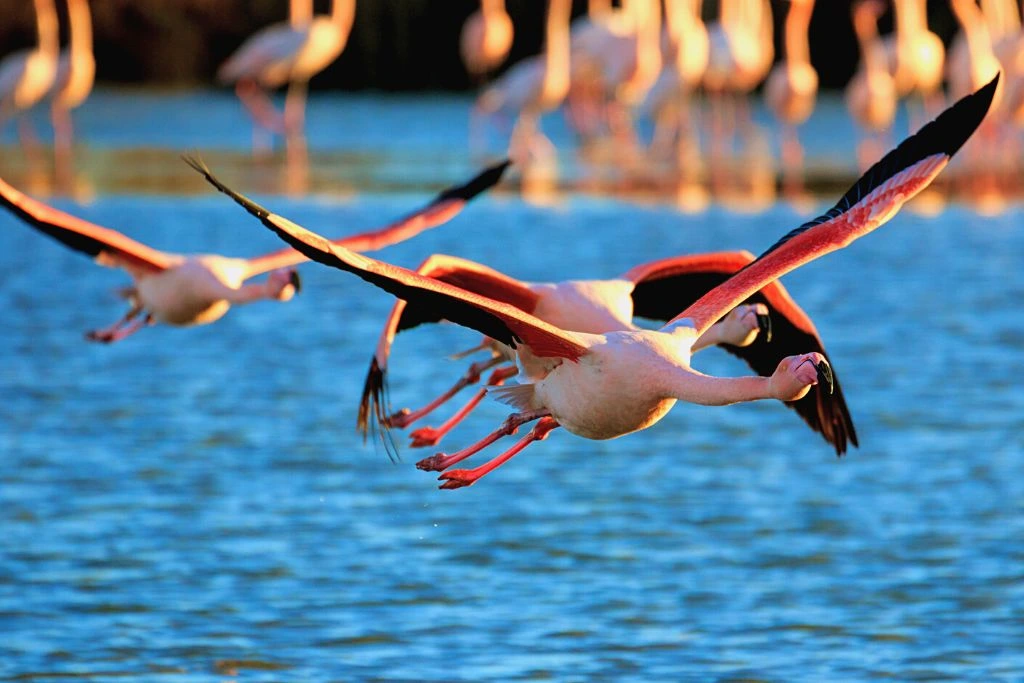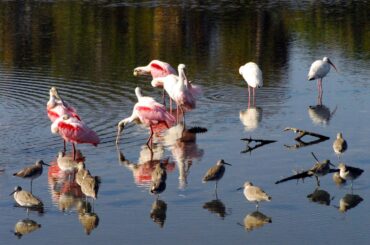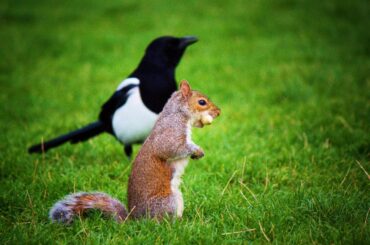Flamingos can fly well, despite their lanky appearance. People often doubt their ability to do so because they’re rarely seen flying in zoos, have stilts for legs, and have equally long necks. As the saying goes, however, don’t judge a book by its cover, nor should your flamingos.
In this article, you will not just learn whether flamingos can fly and how they do so; you will also discover that they can fly at great heights and reach far distances. Some flamingos do this regularly.
Do Flamingos Fly?
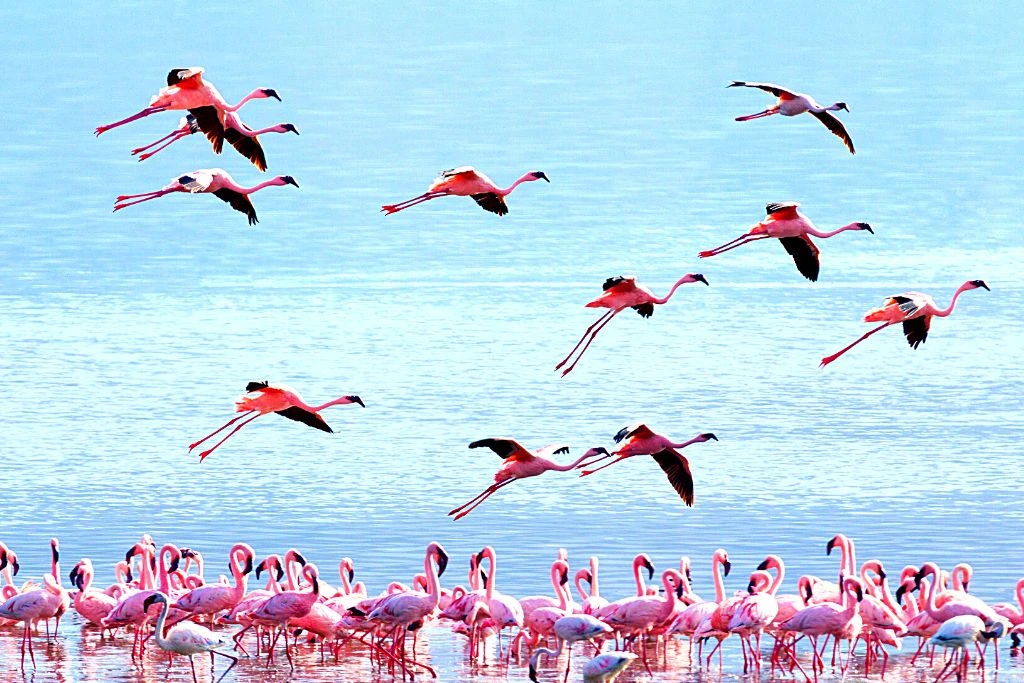
Flamingos are prominently pink birds with distinctive features – tall, stick-like legs; long, graceful necks; and large, protruding beaks. They usually stay in Southern America, Africa, and some parts of India. They can sometimes be spotted in Europe or the Middle East, like Spain, France, and Turkey.
Flamingos do fly, and that’s possible because of their enormous wings. Their wingspan ranges from 37 to 59 inches, or 95 to 150 centimeters, with males and Caribbean flamingos having wider wing spans. They flap and stretch their wings to lift and carry their bodies, which can weigh up to 8.8 lbs, or 4 kg.
How Do Flamingos Fly?

Flamingos fly by using their legs and wings. They’re like airplanes – they run a certain length before flapping their wings and taking off to the sky. Takeoff is easier when the winds are strong; otherwise, they’d have to flap their wings harder or run faster and longer.
Flamingos strategically position their bodies against the wind by keeping their legs, neck, and head horizontally outstretched. This maximizes aerodynamic forces and wind currents. They continuously flap their wings while flying which, while seemingly exhausting, helps them save energy.
When they land, flamingos rely on their legs once again. They slowly bring their legs down vertically, like an airplane dropping its wheels. They also lift their necks and heads so their body becomes upright. Then they touch down and run or walk some distance before slowing to a stop.
Can Flamingos Become Flightless?

Did you know that flamingos can become flightless when molting or shedding their flight feathers to grow new ones? Molting occurs in stages, so not all flight feathers are lost at once. Sometimes, however, simultaneous molting of all flight feathers can happen, so the flamingo has to wait a few weeks before it can fly again.
Another way for flamingos to become flightless is when their flight feathers are purposely trimmed or clipped. Zoos do this to keep their population from flying away. But, as trimming is a hassle, some zoos resort to more extreme measures, like pinioning or tendonotomy.
Pinioning removes the wingtip, so primary flight feathers cannot grow, whereas tendonotomy removes a tendon in the wing, making it harder, if not impossible, for the flamingo to fly.
How Far Can Flamingos Fly?

Flamingos can cover fairly impressive distances, going as far as 373 miles in one trip. Only migrating flamingos reach such lengths, however. There are too many risks of flying too far, like predators, unfavorable winds or weather conditions, exhaustion, lack of food, and other factors.
Flamingos stay in their breeding area as much as they can. They’ll only fly far away because of drought, winter, or high water levels.
Flamingos Prefer Flying At Night
Flamingos also prefer flying during the night for two reasons:
- The dark allows them to fly at lower altitudes because there are fewer predators.
- The wind is more favorable at night, so they’re less likely to get blown over.
Their preference for night flying and relatively high altitudes may explain why you rarely see a flamingo flying.
Flamingos Are Good But Not Great Fliers
The great distance and altitudes reached by flamingos make them good fliers, but they are not as fast or as impressive as birds of prey, like eagles or falcons. Their flying patterns, like covering distances at night, were adapted to avoid these predators.
How Fast Can a Flamingo Fly?
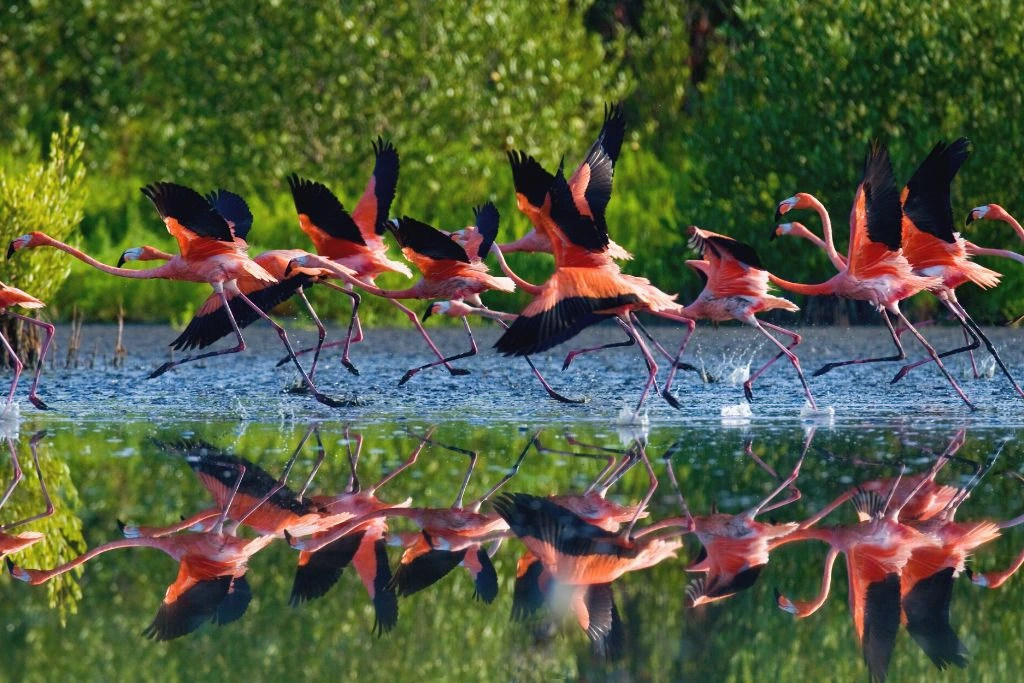
Flamingos can fly as fast as 31 to 37 mph, or 50 to 60 kph. They can fly as quickly as 40 mph, or 64 kph if the winds are excellent.
Those speeds are faster than the average bird flight speed, which is 20 to 30 mph, or 32 kph to 48 kph. But they’re still much slower than birds of prey, like falcons, that can reach more than 200 mph.
Flight speed is affected mainly by wind conditions more than anything else. Flamingos fly faster and spend less energy when the winds are good, but they’ll have to slow down if the gust is strongly against them.
How High Can Flamingos Fly?
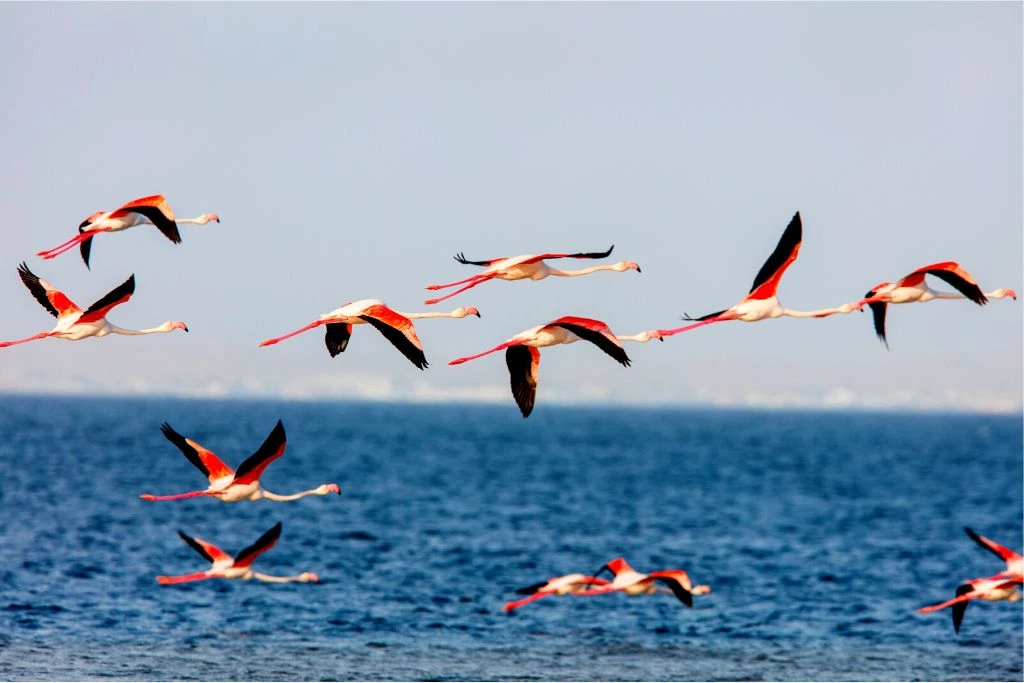
Flamingos can reach heights as high as 20,000 ft, or 6 km. That’s a maximum limit only achieved by flamingos living in the Andes mountain range region, which is so high up by itself, that they’re forced to fly high.
Flamingos may fly higher when they migrate because, at high altitudes, they can take advantage of the wind and the weakening gravity force to take them farther with lesser energy. They also avoid dehydration because it’s less hot at specific heights.
A flamingo in flight usually sticks to heights of 10,000 to 13,000 feet or 3 to 4 km only. That’s because flying higher can also have disadvantages, like strong winds that can topple them, intense pressure, less oxygen, and high-flying predators.
Flamingos Can Fly For A Whole Night
Flamingos also have great endurance. They can stay long in the air, like a whole night, especially if the wind conditions and weather are favorable. The longest distance a flamingo continuously covered in one night was approximately 683 miles or 1100 km.
Do Flamingos Fly in Formation?
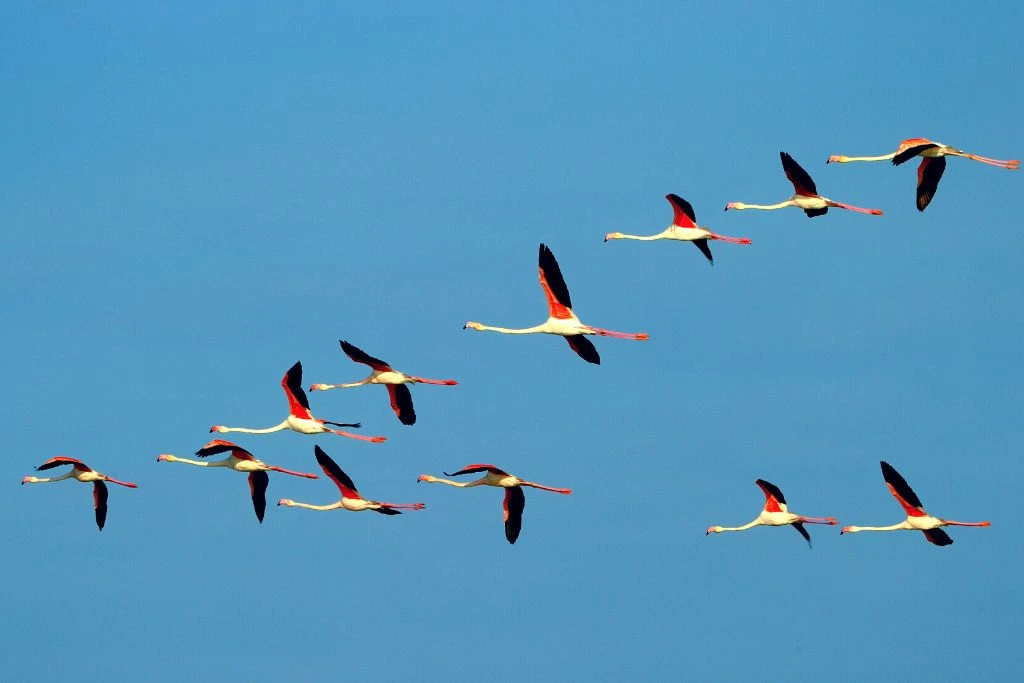
Like other birds, flamingos fly with their flock, called a flamboyance or colony. They usually follow a V-shaped formation but can also arrange themselves into a row or ball-like pattern.
Flight formation is crucial in saving energy, especially during migration. As mentioned, flamingos continuously flap their wings during flight. This allows them to do many things:
- Provide wind to lift the birds on the back portion of the formation
- Break air resistance
- Take advantage of the wind so it can push them farther and faster
A V formation is good for communication. As flamingos fly, they express themselves through vocalizations that are better heard if the formation is maintained. This helps the group avoid threats, like predators, and remain updated on members’ positions.
Do Flamingos Migrate?
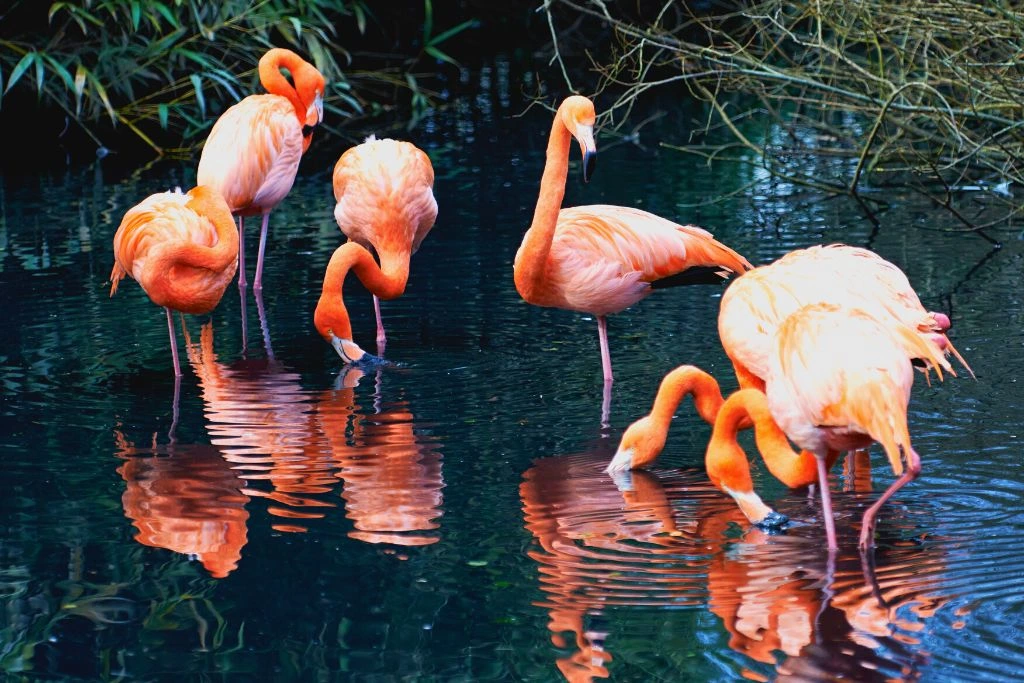
Most flamingos aren’t migratory birds. They typically stay in their breeding grounds as long as the food is adequate and no drought threatens the supply.
The flamingos’ long legs also allow them to wade into deep waters to escape predators, so they’re also unlikely to fly away because of predatory threats.
Although uncommon, flamingo migration is not impossible. There are two known species that migrate: the Andean and great flamingos.
Andean Flamingos
One species of flamingo that does regularly migrate is the Andean flamingo. This rarest flamingo species lives and breeds in the Andes lakes, located 11,000 to 15,000 feet above sea level. These lakes can freeze over the winter, leaving the birds with no food.
Andean flamingos temporarily migrate to lower elevations of 210 feet above sea level to escape the cold. They spend the winter there and then return to their elevated breeding grounds during the summer.
Great Flamingos
The great flamingos also migrate for the winter. Some of these birds migrate from Southern France to North Africa. While the distance may seem extreme, migrating helps these flamingos avoid deadly cold spells around their breeding grounds.

